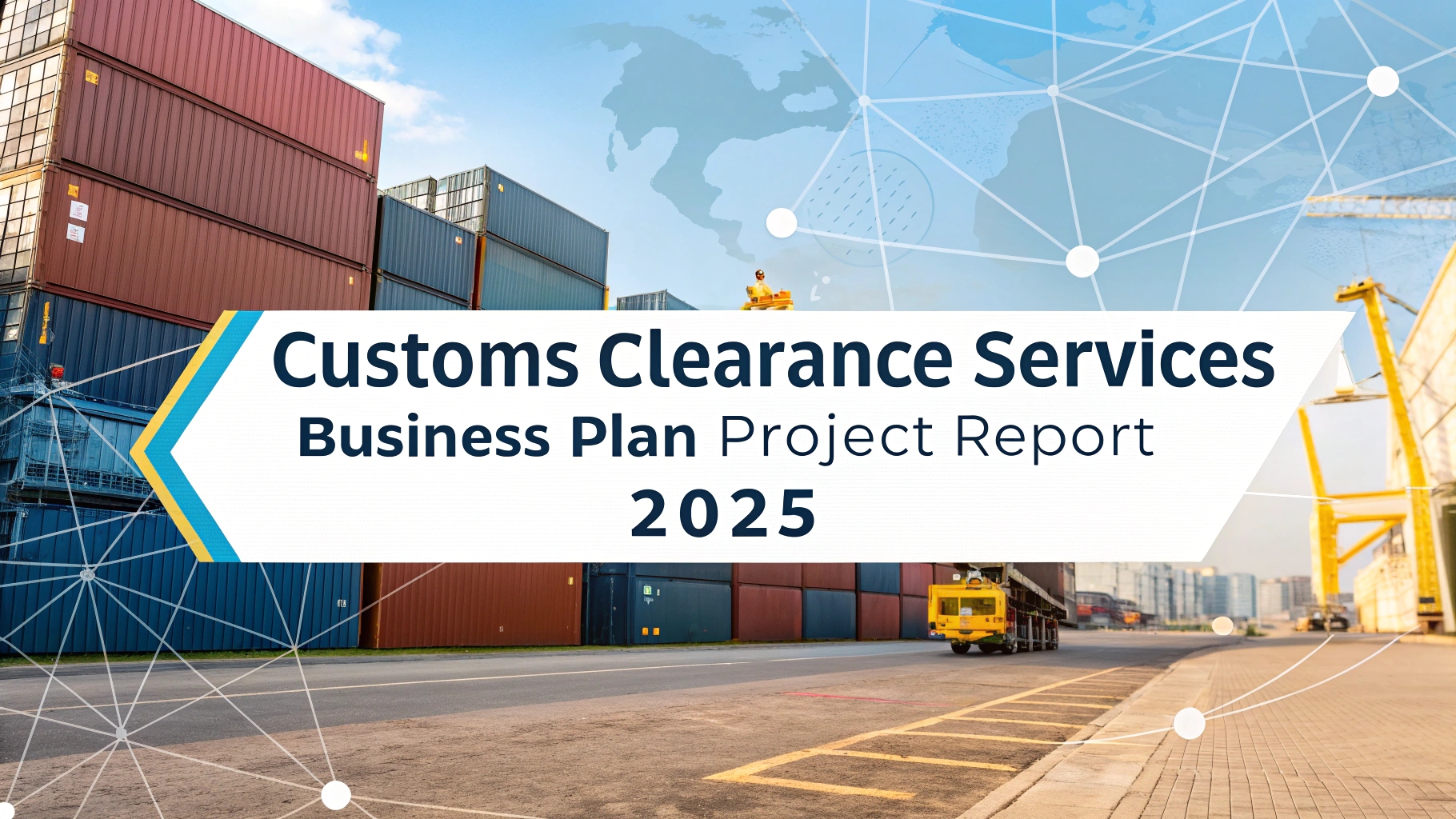Transportation & Logistics Industry Today
How Much Does It Cost to Open a Customs Clearance Services Business in 2025?
Customs Clearance Services Business Plan & Project Report Overview
IMARC Group's "Customs Clearance Services Business Plan and Project Report 2025" offers a comprehensive framework for establishing a successful customs clearance services business. The critical areas, including market trends, investment opportunities, revenue models, and financial forecasts, are discussed in this in-depth report and are therefore useful resources to entrepreneurs, consultants and investors. Whether evaluating the viability of a new venture or streamlining an existing one, the report gives an in-depth analysis of all the ingredients that make it successful, starting with business formation and profitability over time.
What is a Customs Clearance Services Business?
A Customs Clearance Services business is a specialized trade facilitation firm designed to deliver comprehensive customs brokerage and import-export documentation solutions. These organizations emphasize regulatory compliance using tariff classification expertise, customs documentation preparation, duty calculation methodologies, trade compliance protocols, regulatory filing systems, and evidence-based clearance strategies, catering to importers, exporters, manufacturers, e-commerce businesses, and logistics providers seeking efficient movement of goods across international borders.
They offer a variety of services including customs entry filing, import and export documentation, tariff classification and valuation, duty and tax calculation, customs bond procurement, trade compliance consulting, preferential trade agreement utilization, product registration and licensing, customs audit support, and regulatory advisory for businesses committed to seamless international trade operations.
The category encompasses full-service customs brokers, licensed customs house agents, trade compliance consultancies, and freight forwarding firms with customs capabilities, each prioritizing regulatory compliance, documentation accuracy, duty optimization, clearance speed, risk mitigation, client education, supply chain efficiency, and comprehensive stakeholder collaboration.

To achieve these goals, Customs Clearance Services integrate state-of-the-art customs management software, automated clearance systems, tariff classification databases, trade compliance platforms, document management technologies, duty calculation tools, electronic filing systems, and customs tracking analytics.
Depending on their positioning, these establishments may operate as independent customs brokers, integrated logistics service providers, trade compliance specialists, or comprehensive border management partners, delivering complete clearance services tailored to diverse cargo types, trade lanes, and levels of regulatory complexity.
Request for a Sample Report: https://www.imarcgroup.com/customs-clearance-services-business-plan-project-report/requestsample
Customs Clearance Services Business Market Trends and Growth Drivers
The trends and drivers of a Customs Clearance Services business are shaped by the rising volume of global trade, growing complexity of international trade regulations, and the increasing demand for supply chain efficiency and speed-to-market. These factors, combined with a stronger focus on trade compliance and risk management, are fuelling demand for professional customs clearance solutions. Contributing to this shift is the expanding interest in e-commerce cross-border sales, free trade agreement utilization, direct-to-consumer imports, customs modernization initiatives, along with the client preference for transparent fee structures, real-time shipment visibility, and accessible trade compliance guidance within the evolving international commerce ecosystem.
To meet these demands, operators are investing in advanced customs automation platforms, electronic data interchange systems, artificial intelligence for classification, trade compliance software, and compliance with World Customs Organization standards and national customs regulations. These investments not only enhance clearance efficiency but also strengthen business outcomes by aligning with broader trends in global trade facilitation and supply chain digitization.
Revenue diversification is another critical factor in building financial resilience. In addition to direct customs clearance fees, income streams may include trade compliance consulting, tariff engineering services, duty drawback recovery, free trade agreement advisory, customs audit representation, product classification opinions, training and certification programs, and value-added logistics services.
Location and network strength play a vital role in success. Firms positioned near major ports, airports, land borders, and free trade zones with access to customs authorities, cargo terminals, and established trade routes benefit from operational efficiency and client convenience. At the same time, sophisticated clearance management systems, compliance with customs licensing requirements, and adherence to international trade regulations ensure operational excellence and client confidence.
However, the business also faces risk factors, such as rapidly changing customs regulations that can affect clearance procedures, intense competition from established customs brokers and freight forwarder integrated services, dependence on trade volumes and economic conditions, and operational challenges related to customs penalties, shipment delays, and documentation errors.
A successful Customs Clearance Services business model requires careful financial planning—including capital investment in office infrastructure and customs technology systems, procurement of customs management software and compliance databases, and adoption of comprehensive quality assurance frameworks. It also demands licensed customs brokers, trade compliance specialists, and documentation experts, supported by effective marketing strategies to build client relationships, foster trust, and establish long-term partnerships with importers, exporters, manufacturers, and supply chain managers. By delivering accurate documentation, rapid clearance processing, and exceptional regulatory expertise, these businesses can facilitate international trade while helping clients minimize costs, reduce delays, and maintain customs compliance.
Report Coverage
The Customs Clearance Services Business Plan and Project Report includes the following areas of focus:
- Business Model & Operations Plan
- Technical Feasibility
- Financial Feasibility
- Market Analysis
- Marketing & Sales Strategy
- Risk Assessment & Mitigation
- Licensing & Certification Requirements
The comprehensive nature of this report ensures that all aspects of the business are covered, from market trends and risk mitigation to regulatory requirements and client-focused service delivery strategies.
Key Elements of Customs Clearance Services Business Setup
Business Model & Operations Plan
A solid business model is crucial to a successful venture. The report covers:
- Service Overview: A breakdown of import customs clearance, export documentation, tariff classification services, customs bond management, duty calculation and payment, trade compliance consulting, free trade agreement certification, product registration assistance, customs audit support, and regulatory advisory services offered
- Service Workflow: How each shipment notification, documentation review, tariff classification, customs entry filing, duty assessment, examination coordination, clearance release, and delivery authorization process is managed
- Revenue Model: An exploration of the mechanisms driving revenue across multiple trade lanes and customs services
- SOPs & Service Standards: Guidelines for consistent documentation accuracy, clearance processing standards, regulatory compliance practices, and client satisfaction
This section ensures that all operational and service delivery aspects are clearly defined, making it easier to scale and maintain service excellence.
Buy Report Now: https://www.imarcgroup.com/checkout?id=43663&method=1911
Technical Feasibility
Setting up a successful business requires proper customs operations infrastructure planning. The report includes:
- Location Selection Criteria: Key factors to consider when choosing office locations and target customs service markets
- Space & Costs: Estimations for required office space, document processing areas, client meeting facilities, and associated costs
- Equipment & Systems: Identifying essential customs management software, automated clearance platforms, tariff classification databases, and trade compliance technology
- Office & Technology Setup: Guidelines for creating efficient customs operations facilities and secure document management infrastructure
- Utility Requirements & Costs: Understanding the IT infrastructure and utilities necessary to run customs clearance operations
- Human Resources & Wages: Estimating staffing needs, roles, and compensation for licensed customs brokers, trade compliance specialists, documentation processors, client service representatives, and support personnel
This section provides practical, actionable insights into the business infrastructure needed for setting up your business, ensuring regulatory compliance and operational efficiency.
Financial Feasibility
The Customs Clearance Services Business Plan and Project Report provides a detailed analysis of the financial landscape, including:
- Capital Investments & Operating Costs: Breakdown of initial and ongoing investments
- Revenue & Expenditure Projections: Projected income and cost estimates for the first five years
- Profit & Loss Analysis: A clear picture of expected financial outcomes
- Taxation & Depreciation: Understanding tax obligations and technology depreciation
- ROI, NPV & Sensitivity Analysis: Comprehensive financial evaluations to assess profitability
This in-depth financial analysis supports effective decision-making and helps secure funding, making it an essential tool for evaluating the business's potential.
Market Insights & Strategy
Market Analysis
A deep dive into the customs clearance services market, including:
- Industry Trends & Segmentation: Identifying emerging trends and key market segments across import clearance, export documentation, e-commerce customs facilitation, specialized cargo handling, and trade compliance consulting
- Regional Demand & Cost Structure: Regional variations in trade volumes and cost factors affecting customs clearance operations
- Competitive Landscape: An analysis of the competitive environment including established customs brokers, freight forwarder customs divisions, logistics company integrated services, and specialized trade compliance firms
Profiles of Key Players
The report provides detailed profiles of leading players in the industry, offering a valuable benchmark for new businesses. It highlights their strategies, service offerings, technology platforms, and market positioning, helping you identify strategic opportunities and areas for differentiation.
Capital & Operational Expenditure Breakdown
The report includes a comprehensive breakdown of both capital and operational costs, helping you plan for financial success. The detailed estimates for facility development, technology systems, and operating costs ensure you're well-prepared for both initial investments and ongoing expenses.
- Capital Expenditure (CapEx): Focused on office space setup and design, customs management software, automated clearance systems, tariff classification databases, document management platforms, and client portal technology
- Operational Expenditure (OpEx): Covers ongoing costs like staff salaries, customs broker licensing fees, software subscriptions, professional liability insurance, customs bond costs, continuing education, and facility maintenance
Financial projections ensure you're prepared for cost fluctuations, including adjustments for technology upgrade cycles, competitive pricing pressures, regulatory requirement changes, and trade volume variations over time.
Profitability Projections
The report outlines a detailed profitability analysis over the first five years of operations, including projections for:
- Total revenue from customs clearance fees, trade compliance consulting, duty drawback services, and value-added logistics offerings, expenditure breakdown, gross profit, and net profit
- Profit margins for each service line and year of operation
- Revenue per shipment projections and market penetration growth estimates
These projections offer a clear picture of the expected financial performance and profitability of the business, allowing for better planning and informed decision-making.
Request For Customization: https://www.imarcgroup.com/request?type=report&id=43663&flag=E
About Us
IMARC Group is a leading global market research and management consulting firm. We specialize in helping organizations identify opportunities, mitigate risks, and create impactful business strategies.
Our expertise includes:
- Market Entry and Expansion Strategy
- Feasibility Studies and Business Planning
- Company Incorporation and Customs Services Setup Support
- Regulatory and Licensing Navigation
- Competitive Analysis and Benchmarking
- Industry Partnership Development
- Branding, Marketing, and Client-Focused Business Strategy
Contact Us:
IMARC Group
134 N 4th St. Brooklyn, NY 11249, USA
Email: sales@imarcgroup.com
Tel No:(D) +91 120 433 0800
United States: (+1-201971-6302)
Share on Social Media



Other Industry News
Ready to start publishing
Sign Up today!








